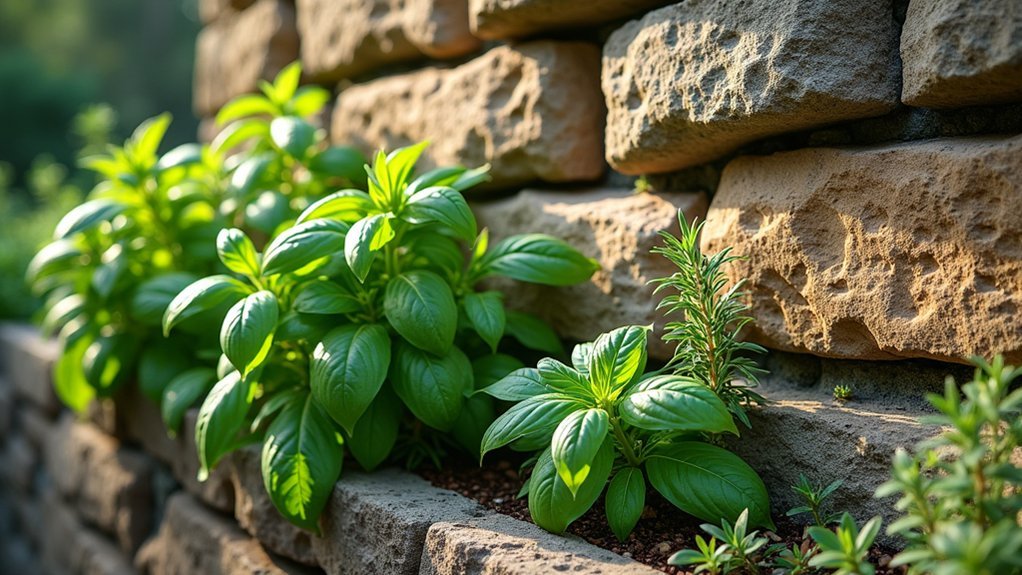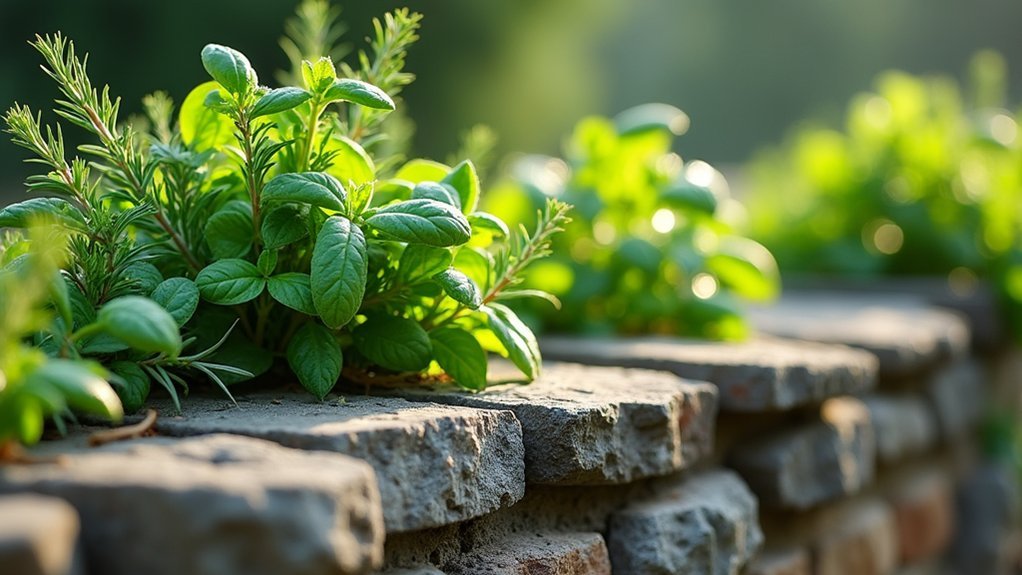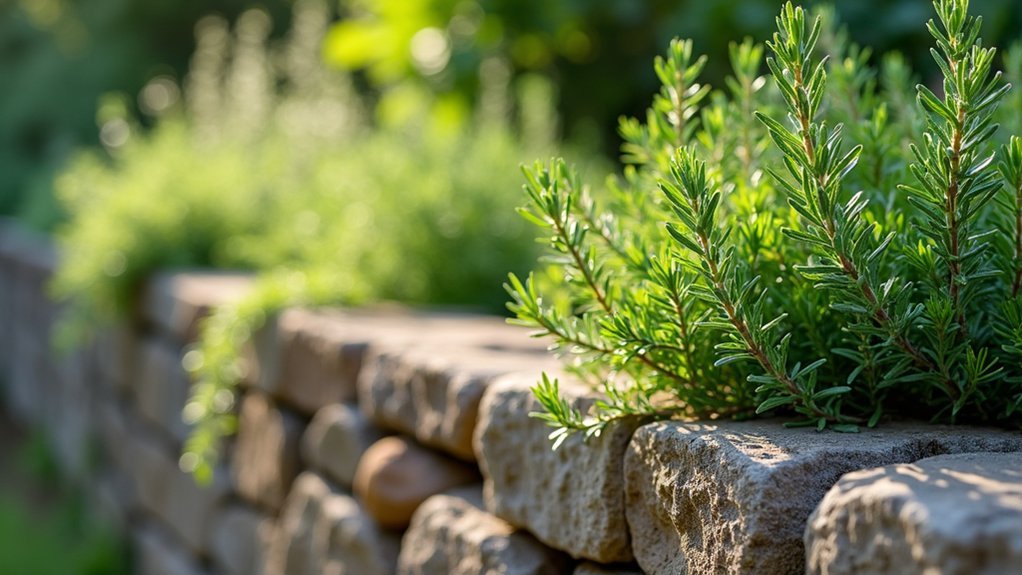Natural stone walls create ideal microclimates for herb gardens by moderating temperatures, blocking harsh winds, and providing excellent drainage. You’ll enjoy improved herb flavors and yields as stones absorb heat during the day and release it at night, extending your growing season. These durable borders require minimal maintenance while enhancing your property’s visual appeal and value. The stone crevices also attract beneficial insects, creating a thriving mini-ecosystem. Discover how these timeless structures transform ordinary herbs into culinary and medicinal powerhouses.
10 Second-Level Headings for “Why Choose Natural Stone Walls For Herb Borders?”

How do you create herb borders that are both functional and beautiful? Natural stone retaining walls offer a practical and stunning solution for your garden design.
When planning your herb border, consider these key benefits: soil retention and drainage excellence, enhanced visual appeal, microclimate creation, durability, and increased property value.
Natural stone walls provide the ideal environment for herbs by maintaining soil integrity while allowing proper water movement through the root systems. Your herbs will thrive in the protective microclimates these walls create, offering shelter from harsh weather and retaining warmth to promote healthier growth.
Beyond functionality, the timeless aesthetic of stone walls seamlessly integrates with your garden landscape, requiring minimal maintenance while aging gracefully. You’ll enjoy both the immediate beauty and long-term value these walls bring to your herb garden.
The Perfect Microclimate: How Stone Walls Benefit Herb Growth
Among the most fascinating advantages of natural stone walls is their ability to transform your herb garden’s growing conditions.
These structures create a protective microclimate that works wonders for delicate herbs. As the stone absorbs heat during daylight hours, it releases this warmth gradually when temperatures drop, keeping your herbs cozy during cool mornings and evenings.
You’ll notice your herbs thrive when planted near stone walls, as the consistent soil temperature nurtures stronger root systems.
The walls also shield plants from harsh winds while their unique crevices retain moisture, reducing your watering duties.
Stone walls serve as natural guardians, blocking fierce winds while storing precious moisture in their nooks.
For ideal flavor and robust growth, the elevated position of herbs against stone walls captures optimal sunlight, enhancing both yield and potency of your culinary and medicinal plants.
Soil Retention and Drainage Benefits for Herb Vitality

Natural stone walls offer you essential soil retention that prevents erosion and creates stable growing conditions for your herb borders.
You’ll notice improved water management as the porous stones provide effective drainage, preventing root rot that often plagues poorly drained herb gardens.
Your herbs will thrive with this perfect balance of moisture retention and drainage, promoting healthy root development in a consistently supportive growing environment.
Preventing Root Rot
Root rot threatens even the hardiest herbs when soil becomes waterlogged, but well-designed stone walls offer a powerful defense against this common gardening challenge. The porous nature of natural stone creates ideal drainage solutions that prevent excess moisture from damaging your herbs’ root systems.
Your stone wall’s structure actively regulates soil moisture through strategic design elements that maintain the perfect balance herbs need to thrive. When you incorporate proper drainage into your stone border, you’ll considerably reduce root rot risk.
| Stone Feature | Drainage Benefit | Root Protection |
|---|---|---|
| Porous surface | Absorbs excess water | Prevents saturation |
| Weep holes | Releases trapped moisture | Maintains aeration |
| Gravel backfill | Creates water channels | Reduces waterlogging |
| Temperature regulation | Stabilizes moisture cycles | Supports healthy roots |
Enhanced Water Management
While herb gardens require consistent moisture, they quickly suffer when water management fails. Natural stone walls offer excellent water management for your herb borders while maintaining a beautiful natural look.
Their porous structure creates the perfect balance—preventing waterlogging yet keeping essential moisture available to herb roots.
You’ll notice how stone walls effectively trap water in the soil by preventing erosion, ensuring your herbs have consistent access to moisture even during dry spells.
The elevated design also enhances air circulation around plants, greatly reducing the risk of fungal diseases that thrive in stagnant moisture.
When properly constructed with integrated drainage systems, your stone wall will channel excess water away from vulnerable herb roots, creating a microclimate that maintains ideal moisture levels throughout changing weather conditions.
Stable Growing Conditions
Stability forms the cornerstone of successful herb gardening, and stone walls deliver this essential quality through exceptional soil retention capabilities.
Your herbs will thrive in the controlled environment created by these natural structures, which prevent erosion while maintaining ideal growing conditions.
Stone walls provide three key benefits for herb health:
- Natural drainage – The gravity-based design allows excess water to flow away, preventing waterlogging that can damage delicate herb roots.
- Microclimate creation – The stone absorbs heat during the day and releases it at night, moderating temperature fluctuations.
- Enhanced root health – The porous nature of natural stone promotes air circulation and proper moisture levels in the soil.
With strategic drainage features like weep holes, your stone borders will create stable, thriving habitats for your herb collection year-round.
Stone Selection: Finding the Right Materials for Your Herb Border

When designing your herb border, the foundation of success lies in selecting the right stones. Opt for limestone or sandstone, which provide both durability and a natural aesthetic that beautifully frames your herbs.
Your wall will thrive when built with smaller, flatter stones that create stable, level surfaces for easy planting and maintenance.
Look to local suppliers for field stones compatible with your regional climate—this approach reduces costs while ensuring your border withstands local weather patterns. Choose stones with varied textures and colors to enhance visual appeal while providing proper drainage for herb roots.
Don’t overlook thickness; your stones must be substantial enough to resist soil pressure and prevent shifting, maintaining your herb border’s integrity for years to come.
Seasonal Considerations: How Stone Walls Protect Herbs Year-Round
Throughout the changing seasons, natural stone walls serve as silent guardians for your herb garden. Their thermal mass properties create a microclimate that extends your growing season by absorbing daytime heat and releasing it when temperatures drop. This protection is invaluable for delicate herbs in your planting beds.
Stone walls offer year-round benefits:
- Winter protection – Walls insulate soil and shield roots from freezing temperatures, allowing many herbs to survive colder months.
- Spring and fall extension – The heat-retention properties give your herbs extra growing weeks on either end of the season.
- Summer stability – Walls provide consistent growing conditions by blocking harsh winds and preventing soil temperature fluctuations.
You’ll also enjoy improved drainage when herbs are elevated in wall-supported beds, preventing the root rot that often claims herb gardens during wet seasons.
Design Principles for Integrating Herbs With Stone Structures

When designing your herb-stone integration, consider how elevation changes create beneficial microclimates that protect delicate herbs while enhancing drainage.
You’ll find that south-facing stone walls absorb heat during the day and release it at night, extending your growing season for Mediterranean herbs like rosemary and lavender.
Remember that effective design balances aesthetic appeal with practical function, allowing your herbs to thrive while the stone structures provide structural support and visual interest.
Elevation Creates Microclimates
Because stone walls elevate herb borders above the surrounding landscape, they create valuable microclimates that can dramatically improve your herbs’ growing conditions. This elevation doesn’t just look attractive—it serves multiple practical purposes. The raised position enhances drainage, preventing waterlogged roots while maintaining optimal moisture levels for herbs that prefer drier conditions.
Stone’s thermal properties work to your advantage in three key ways:
- Walls absorb heat during daylight hours and radiate it back to plants at night, extending growing seasons.
- The stable thermal mass regulates soil temperature fluctuations, protecting sensitive root systems.
- Strategic elevation creates sheltered pockets that shield delicate herbs from harsh winds.
You’ll find that different sections of your stone wall border offer varying light and moisture conditions, allowing you to match each herb to its best-suited microclimate.
Form Follows Function
As you design your herb border alongside natural stone walls, the ancient principle of “form follows function” should guide your planning decisions.
Create planting pockets that accommodate small-rooted herbs while providing essential drainage to prevent root rot.
Layer your herbs strategically along the natural walls—place taller varieties at the back and shorter ones in front for visual interest and easier harvesting. This arrangement guarantees smaller herbs aren’t shaded by larger ones while maximizing your available space.
Choose drought-tolerant herbs that complement the low-maintenance benefits of stone structures. These plants require less water and care, making your border more sustainable over time.
Remember that the stone’s solid structure offers built-in protection from harsh weather conditions, creating sheltered environments where delicate herbs can thrive despite strong winds or heavy rains.
Culinary and Medicinal Benefits of Stone-Bordered Herb Gardens
While most gardeners appreciate the visual charm of herb gardens, stone-bordered designs elevate both their functionality and health benefits. Your garden beds enclosed with stacked stone walls create perfect microclimates that enhance the flavor profiles and medicinal properties of your culinary herbs.
The benefits extend beyond aesthetics:
Stone borders create microclimates that transform herb gardens from merely attractive to powerhouses of flavor and healing.
- Enhanced flavor production – The improved drainage and temperature regulation from stone borders increases essential oil concentration in herbs like rosemary and thyme.
- Easier harvesting access – Raised stone borders bring herbs closer to convenient cutting height for your cooking needs.
- Medicinal potency – Herbs grown in stone-bordered gardens often develop stronger therapeutic compounds due to ideal growing conditions.
You’ll enjoy these dual culinary and medicinal advantages while maintaining an organized, beautiful outdoor cooking and entertaining space.
Low-Maintenance Pairing: Stone Durability Meets Herb Resilience

You’ll find that natural stone walls create a resilient microclimate that shelters herbs while minimizing maintenance demands.
Your stone borders won’t require replacement or treatment, unlike wood alternatives that deteriorate over time.
These durable structures retain heat during cooler periods and reduce watering requirements, particularly for drought-tolerant herbs that thrive in the well-drained environment.
Weatherproof Protection
Natural stone walls create the perfect partnership with herb gardens by offering exceptional weatherproof protection that’s virtually maintenance-free.
Your herbs will thrive behind these freestanding walls that shield delicate plants from harsh elements while creating an ideal microclimate for growth.
Stone’s protective benefits include:
- Temperature regulation – Natural stone absorbs heat during the day and releases it slowly at night, maintaining stable soil temperatures that help herbs develop stronger root systems.
- Moisture balance – The porous structure allows proper drainage while retaining essential humidity, preventing both waterlogging and drought stress.
- Wind barrier – A sturdy freestanding wall blocks damaging winds that can dry out or physically damage tender herb foliage.
You’ll notice healthier herbs with more vibrant flavors thanks to these protective qualities that simply can’t be matched by synthetic alternatives.
Reduced Watering Needs
Gardeners who pair stone walls with herb gardens enjoy a remarkably water-efficient system that practically maintains itself.
Your natural stone borders create a microclimate that retains moisture in the soil, considerably reducing your garden’s irrigation needs, especially during dry spells.
The stone’s thermal mass works to your advantage—absorbing daytime heat and releasing it gradually at night—creating ideal growing conditions that minimize watering frequency.
Most herbs thrive in these well-drained environments, as their drought-tolerant nature perfectly complements the stone’s stability.
Wildlife Habitats: How Stone Herb Borders Enhance Biodiversity
While many view stone herb borders as mere decorative elements, they actually serve as thriving wildlife sanctuaries that considerably boost biodiversity in your garden.
These landscape design features create crucial microhabitats that support a wide variety of species, forming an interconnected ecosystem right in your backyard.
Your stone herb borders facilitate wildlife habitats in three key ways:
- The crevices between stones provide shelter and nesting sites for beneficial insects and small animals.
- Diverse herb plantings attract essential pollinators, enhancing your garden’s productivity.
- Natural stone construction minimizes chemical runoff, promoting healthier soil ecosystems.
Companion Planting Strategies Within Stone Wall Systems
When designed thoughtfully, stone wall herb borders create perfect opportunities for companion planting—a practice that maximizes your garden’s potential through strategic plant pairings. Your stone walls establish distinct planting zones, reducing competition for resources while creating microclimates that benefit tender herbs like basil and rosemary.
Try planting basil alongside tomatoes in your flower bed to enhance growth and increase yields for both plants. The natural warmth radiating from your stone walls provides added protection for these beneficial combinations.
You’ll also improve pest management by incorporating aromatic herbs such as lavender and sage, which deter harmful insects while attracting beneficial ones. This creates a balanced ecosystem within your garden space.
The stone structure’s water management properties help retain moisture for companions requiring consistent hydration, ensuring your strategically paired plants thrive together.
Frequently Asked Questions
What Are the Benefits of Stone Walls?
Stone walls give you excellent drainage, enduring durability, and enhanced aesthetic appeal. They’ll increase your property value while requiring minimal maintenance. You’ll appreciate how they naturally blend with landscapes and age beautifully over time.
What Are the Benefits of Using Natural Stone Wall Cladding?
Natural stone wall cladding offers you durability, aesthetic beauty, and temperature regulation. It’ll enhance your property’s character with unique textures while creating defined planting areas that improve soil retention and drainage for healthier growth.
What Is the Disadvantage of a Stone Wall?
Stone walls are expensive, costing $600-$1000 per pallet. You’ll face ongoing maintenance as weeds grow between stones. They’re labor-intensive to install, difficult to modify later, and can’t prevent soil runoff during heavy rains.
Why Did They Build a Stone Wall?
They built stone walls to manage soil erosion, create stable growing environments, and define garden spaces. You’ll find they also retain heat, enhance drainage, and provide lasting durability while blending naturally with the landscape.
In Summary
You’ll find natural stone walls transform your herb borders into thriving ecosystems. They provide the perfect microclimate, excellent drainage, and year-round protection while requiring minimal maintenance. As your herbs flourish against the weathered backdrop, you’re creating not just a beautiful garden feature, but a functional space that supports wildlife, enhances biodiversity, and delivers superior culinary and medicinal harvests. It’s an investment in both aesthetics and productivity.





Leave a Reply